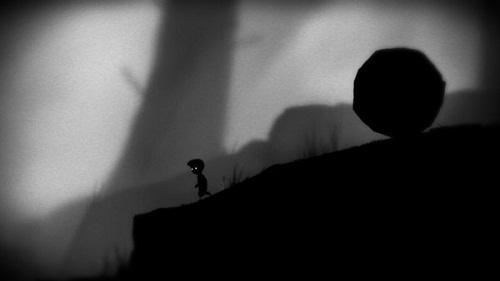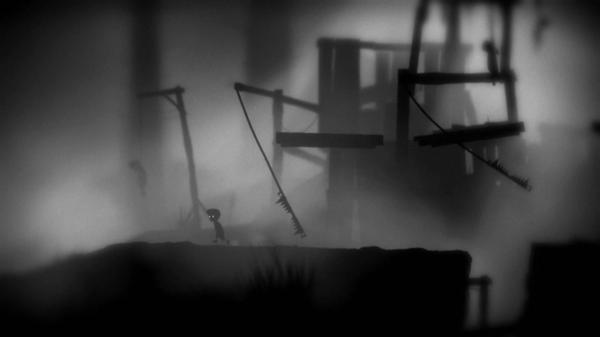Limbo PC Review
Last summer, Playdead Studios released Limbo for Xbox Live Arcade, and it has left an indelible impact on the independent gaming scene. The beautiful art style, open ended story and puzzle platforming combined to form a unique, memorable experience. A year later, Limbo has arrived for the PC and PS3 with some additional content. Is the PC version a faithful port of the Xbox 360 award-winner, or is it an inferior experience to the original?
Limbo opens with the protagonist, a little boy, waking up in a sinister forest. There is no dialogue, writing, or other methods of traditional storytelling or progression. Instead, it is up to the player to interpret meaning out of the environment and events as the boy moves through the world. It's not limited to the forest, with later areas closely resembling factories or rooftops of cities. This method of storytelling is unconventional, and the quality of the story is up to the player's own opinion and prejudices. As such, I didn't enjoy the story in Limbo. Why? I found that no matter how I tried, I couldn't figure out a coherent story for the game, both when viewed as literal and metaphorical. There are some powerful symbols in Limbo, like parasites which drill into the protagonist's head and aren't fond of the light. However, these symbols rarely represent anything, let alone in the context of a larger narrative. The ending doesn't help much, either. Rather than answer some of the questions raised (again, both literal and metaphorical), the ending raises more questions, and further confused me. The story is similar to several jigsaw pieces the developer expects you to piece together, but there are more than a few pieces missing.
The gameplay fares much better. The controls feel loose and tactile, letting you climb, swing on ropes, jump, push, pull, grab, and slide smoothly with only a few buttons. The physics of the movement also makes the simple act of jumping feel unique, an essential aspect for a game that starts as simply as Limbo does. At first, you'll only be jumping and pushing objects, but wrinkles in the gameplay soon appear. To name a few moments, the boy may be covered in spiderwebs, only allowing him to jump, or he'll be restricted to running in one direction. During the middle of Limbo, there are more environmental puzzles and creative problem solving, by the end you'll be solving puzzles most of the time. 
The first areas in Limbo are the best, as you explore the environment and come across some great enemies. The ways in which you deal with these foes are memorable, as well. These first sections really let the core controls shine, with creative scenarios to survive. If all of the game had this kind of pacing and gameplay, it would be truly great. However, the last third is far less enjoyable.
The first half of Limbo is very tight, meaning that there aren't many moments which you aren't progressing forward or accomplishing anything, and if you aren't, you're solving quick environmental puzzles to change up the pace. In the last third of the game, however, the pacing takes a nose dive for the worse. Here you encountert some of the more complex puzzles, which take far longer to complete, but are just as easy to solve. This is because these later puzzles have a lot of open space, meaning you have to walk for a while to complete very simple tasks. Buttons, boxes, and anything else you need to complete the puzzles tend to be on the opposite sides of large rooms. To make things worse in the last third, it is comprised mainly of puzzles. After you complete one puzzle, you'll proceed straight to the next puzzle, and then the one after that, with no platforming in between to establish the pace so well defined in the first half of the game.
One thing that stays the same throughout all of Limbo is death. No matter where you are, it is most likely that you will die, in several different ways. The boy can be crushed, shot, sawed, drowned, electrocuted, and more throughout the game. Just because he's a little boy doesn't mean Limbo goes easy on him, in fact, he dies more graphically than many adults in games today. It definitely adds flavor, and creates the feeling that anything can happen in this world.

The presentation in Limbo is incredible. The dark world shown in only blacks, whites, and grays has a memorable atmosphere, conveying different emotions with each new environment. The forest shows creepiness, the factories are full of dread, the city rooftops are somber, and the later, indescribable environments can be downright scary, with dark rooms full of buzz-saws. That being said, it's not just the world that is spectacular, it's the boy as well. His animations are smooth and appropriate, with stumbles after large falls and physical effort shown in pushing larger objects. He will go ragdoll any time he is dead, sometimes resulting in him being flung about by sawblades, or slowly floating after having drowned. The audio is great, too. There is very little music, but when it is used it is incredibly effective, stirring up some primal emotional reactions. The sound effects work is grounded in reality, and when combined with the minimalist music, creates a palpable atmosphere. It's also locked at a 60 frames per second cap, which is disappointing for the PC version.
There are very few differences between the Xbox 360 and PC versions of Limbo. The controls are fine with the keyboard, if a bit less precise than the gamepad, making the gamepad the controller of choice should you have one. The only graphics option is the brightness, as Limbo auto-detects the correct resolution for your monitor. There is an extra challenge room should you unlock all of the collectables, but it doesn't add a lot of time.
Limbo is a very strong argument both for and against the idea of games as art. The atmosphere and fatalistic gameplay combine to create a very memorable and intriguing world, but the story doesn't do justice to it. Limbo is only an hour and 30 minutes, making it a niche title, to say the least. If you're someone who considers games as art, however, Limbo is definitely worth a purchase.

